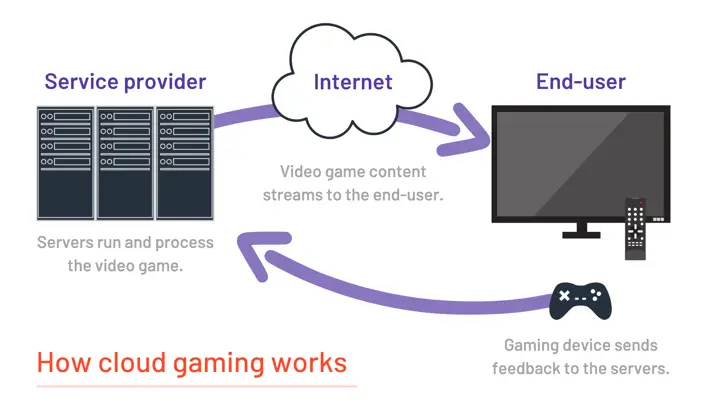Impact of Content Delivery Networks (CDNs) on Cloud Gaming Experience

CDNs play a crucial role in enhancing the cloud gaming experience by optimizing content delivery and minimizing latency. Here are some of their key impacts:

1. Reduced Latency:

CDNs distribute gaming content across a network of servers located near users. By caching game assets locally, CDNs reduce the distance that data must travel, significantly lowering latency. This results in real-time responsiveness and a smoother gaming experience.
2. Improved Video Quality:
CDNs employ adaptive bitrate streaming technologies to deliver video content at the highest possible quality while minimizing buffering. They adjust the bitrate based on user bandwidth and network conditions, ensuring a consistent and immersive gaming experience.
3. Reduced Jitter and Packet Loss:
CDNs use advanced routing algorithms to minimize fluctuations in network performance (jitter) and prevent packet loss. This ensures a stable and consistent gaming session, preventing interruptions or disconnections.
4. Scalability and Reliability:
CDNs are designed to handle large volumes of traffic and maintain high uptime. They can easily scale up or down to meet demand, ensuring that players have a consistent experience even during peak hours. Moreover, CDNs offer redundancy, meaning that if one server fails, others can take over seamlessing.
5. Security and Data Protection:
CDNs implement robust security measures to protect user data and prevent unauthorized access. They employ encryption, access control, and threat detection systems to ensure the confidentiality and integrity of gaming content.
6. Geographic Availability:
CDNs have a global presence, with servers located in multiple regions. This allows cloud gaming platforms to reach a wider audience and provide a seamless experience for players worldwide.
7. Cost Optimization:
By utilizing CDNs, cloud gaming platforms can reduce their bandwidth costs and improve resource utilization. CDNs optimize content delivery, reducing the amount of data that needs to be transferred.
8. Multi-Player Support:
CDNs enable efficient multiplayer gaming by optimizing communication between players. They minimize lag and ensure that all players receive updates in a timely manner, creating a fair and enjoyable gaming environment.
9. Device Agnostic:
CDNs support a wide range of devices, including PCs, consoles, mobile phones, and streaming devices. This allows gamers to access cloud gaming services regardless of their hardware preferences.
10. Innovation and Future Advancements:
CDNs are continuously evolving, adopting new technologies to further enhance the cloud gaming experience. They are exploring advancements such as edge computing, AI-powered routing, and next-generation network architectures to address challenges and improve performance.## The Impact of CDNs on Cloud Gaming Experience
Executive Summary
Content Delivery Networks (CDNs) play a critical role in delivering a seamless and lag-free cloud gaming experience. By caching game content on edge servers located close to end-users, CDNs significantly reduce latency and optimize performance, enabling gamers to enjoy immersive and responsive gaming sessions.
Introduction
Cloud gaming, also known as game streaming, has revolutionized the gaming industry, allowing players to access high-quality games without the need for expensive hardware. However, the quality of the cloud gaming experience hinges on the efficient delivery of game data, which is where CDNs come into play.
FAQ
1. What is a CDN?
A CDN is a distributed network of servers that stores cached content at multiple locations, providing users with faster access to frequently requested data. By delivering game content from a server close to the user’s geographical location, CDNs effectively reduce latency and improve loading times.
2. How do CDNs benefit cloud gaming?
CDNs enhance the cloud gaming experience by:
- Reducing latency: CDNs cache game content on servers located near end-users, minimizing the distance data must travel, resulting in faster load times and smoother gameplay.
- Improving bandwidth utilization: By caching popular game assets on edge servers, CDNs reduce the load on cloud gaming providers’ servers, optimizing bandwidth usage and minimizing potential bottlenecks.
- Enhancing reliability: CDNs provide redundancy by distributing game content across multiple servers, ensuring that players can access their games even in the event of server outages.
3. What are the key factors to consider when choosing a CDN for cloud gaming?
When selecting a CDN for cloud gaming, it’s crucial to evaluate:
- Network coverage: Ensure the CDN has a presence in regions where your target audience is located.
- Latency performance: Choose a CDN that consistently delivers low latency for fast and responsive gameplay.
- Security: Prioritize CDNs that offer robust security measures to protect sensitive player data and game content.
Top 5 Subtopics
1. Latency and Responsiveness
- Reducing input lag: CDNs minimize the time it takes for player inputs to register in the game.
- Eliminating micro-stuttering: CDNs smooth out gameplay by preventing small, momentary pauses caused by data transmission delays.
- Ensuring frame rate consistency: Stable frame rates are vital for a seamless gaming experience. CDNs help maintain consistent frame rates by reducing latency fluctuations.
2. Video Quality and Streaming Optimization
- Optimizing bitrate delivery: CDNs adjust the bitrate of streamed video content based on network conditions, ensuring optimal video quality while minimizing buffering.
- Reducing compression artifacts: CDNs employ advanced compression techniques to minimize image distortion and maintain visual fidelity.
- Enabling adaptive streaming: CDNs allow games to dynamically adjust video quality based on available bandwidth, ensuring a smooth and consistent experience for users with different connection speeds.
3. Scalability and Performance
- Load balancing: CDNs distribute traffic across multiple servers, preventing individual servers from becoming overwhelmed during peak gaming hours.
- Automatic caching: CDNs automatically cache frequently accessed game assets, reducing the load on cloud gaming servers and accelerating content delivery.
- Flexible infrastructure: CDNs offer customizable infrastructure to support different game requirements and scale as the number of gamers increases.
4. Security and Data Protection
- Data encryption: CDNs encrypt game data during transmission to protect it from unauthorized access and interception.
- Secure storage: CDNs securely store cached game content on edge servers to prevent unauthorized downloads.
- Compliance with regulations: CDNs adhere to industry standards and regulations to ensure the confidentiality and privacy of player data.
5. Geo-Distribution and Local Access
- Global reach: CDNs have servers distributed across the globe, enabling players from different regions to access cloud gaming services with minimal latency.
- Regional optimization: CDNs tailor their services to meet the specific needs of different geographic locations, such as optimizing latency for gamers in rural areas.
- Local caching: CDNs cache game content on servers located near end-users, reducing data transmission distances and further minimizing latency.
Conclusion
The integration of CDNs is essential for delivering a superior cloud gaming experience. By leveraging their extensive network infrastructure, CDNs empower cloud gaming providers to reduce latency, enhance performance, and provide a seamless and immersive gaming environment. As cloud gaming continues to grow in popularity, CDNs will play an increasingly vital role in ensuring that gamers can enjoy their favorite games without compromising on quality and responsiveness.
Keyword Tags
- Cloud Gaming
- CDNs
- Latency
- Performance
- Streaming Optimization
